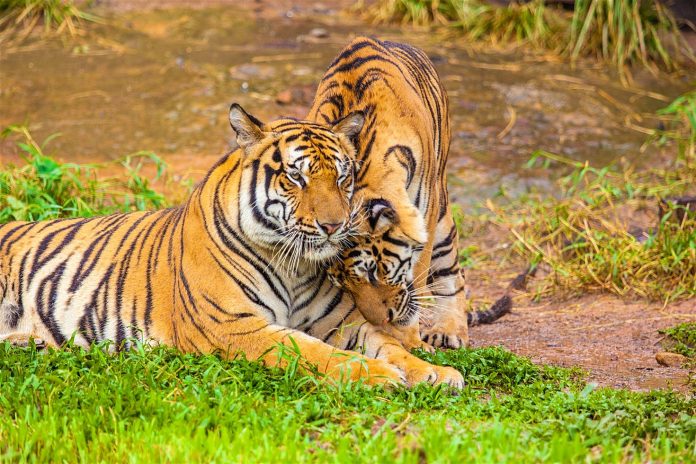The call of the wild – and the wildlife in it – is a powerful one. But as the dark truth behind many wildlife tourism activities becomes ever clearer, the case for responsible tourism has never been stronger. Acknowledging we should be more responsible, however, is only part of it. Learning what this means, and putting it into practice, is key.
‘The important thing to keep in mind is that wild animals are not entertainers,’ says Ben Pearson, Senior Campaign Manager for the Australian branch of international animal welfare non-profit World Animal Protection. ‘If you want to see wildlife on holiday, the best thing you can do is to find somewhere to see it in the wild. The next best option is seeking out a legitimate sanctuary that offers observation only, so the animals are free to display their natural behaviours.’
 Elephants crossing the road in Sri Lanka
Elephants crossing the road in Sri Lanka
This might sounds restrictive, but nothing elevates a wildlife experience more than the knowledge that the animals involved are as comfortable to be in your presence as they make you happy to be in theirs. Follow these tips to ensure you don’t upset the balance.
Keep your distance
It’s not easy to resist our instinct to get up close to wildlife. Scientists even have a name for it – the biophilia hypothesis – which suggests that humans possess an innate tendency to seek connections with nature. But keeping your hands off is usually always in the best interests of the animals involved.
‘If a tourism venue offers the opportunity to ride, touch or get a selfie with a wild animal, there’s a very good chance that animal has been treated cruelly,’ says Pearson. Animal shows, elephant rides, captive dolphin swims, and interacting with big cats are more widely publicised examples of tourism experiences that animal welfare experts claim compromise animal welfare, but plenty of other seemingly harmless interactions can have a similarly devastating impact.
‘Even smaller animals do not cope well with being handled by humans,’ says Pearson, adding that sloths used in the tourism industry typically die within six months of capture.
The alternative? Walking and jeep safaris led by experienced guides not only offer the thrill of observing wildlife in its natural habitat, but also helps to keep the animals – and you – safe.
 Bottlenose dolphins in Mozambique
Bottlenose dolphins in Mozambique
Seek out genuine sanctuaries
Wildlife sanctuaries provide valuable opportunities to view and learn about species that are difficult to see in the wild. In this era of greenwashing, however, it pays to do your research to ensure sanctuaries you plan on visiting are operating in the true sense of the term.
‘Look at where the animals are housed,’ says Pearson. ‘Do they have room to move and display natural behaviours? Is there protection from the weather and somewhere for them to go to be away from visitors?’ Opting to travel with a responsible operator can also help you avoid unwittingly visiting wildlife centres that do not operate in the best interests of their animals. Wannabe wildlife volunteers should also keep in mind that high-welfare sanctuaries do not typically allow direct contact with wildlife.
Resist the urge to feed wildlife
‘Despite your best intentions, feeding wild animals does more harm than good,’ says Pearson. ‘As a result of continued feeding animals become dependent on humans for food, and can become aggressive.’ In the USA and Canada, for example, rangers are often forced to terminate wild bears that pose a risk to humans as a result of being fed. Numerous studies have also concluded that feeding wildlife can wreak havoc with their breeding and migrating patterns.
 Ranthambhore National Park is the best place to spot wild tigers in Rajasthan ©
Ranthambhore National Park is the best place to spot wild tigers in Rajasthan ©
Beware of grey areas
Be mindful that tourism experiences that have been created as a sustainable alternatives to problematic activities often have their own issues.
‘Elephant washing is a big one,’ says Pearson. ‘Many people believe this is a better alternative to riding, but allowing tourists to wash an elephant requires a high level of control over the animal. With mud used as sun protection and to keep elephants cool in the heat, this constant washing can have a negative impact on their welfare, too.’
Another example is swimming with wild marine life that is baited or fed to draw it closer to humans. The whale shark swimming industry in Oslob in the Philippines, for example, has been credited with lifting the local community out of poverty, but the fact that whale sharks only gather here because they are accustomed to being fed has prompted conservationists to question its sustainability.
The good news is that there are hundreds of places around the world listed on our website and in our guidebooks where you can observe elephants, whale sharks and other amazing creatures more responsibly. You might have to travel a bit further, or pay a bit more, but at least you can be sure you’re not compromising the wildlife involved.
Watch what you eat
Did you know you can help to protect wildlife simply by watching what you eat on your travels?
‘We encourage travellers to avoid things like bush meat, which is often hunted and killed inhumanely,’ says Pearson. And don’t forget your drinks. Popular in Southeast Asia, snake wine is typically made by drowning a live snake in alcohol, while coffee luwak is produced by caging and force-feeding civet cats.
 A whale shark feeding © Fata Morgana by Andrew Marriott
A whale shark feeding © Fata Morgana by Andrew Marriott
Shop wisely
Avoiding souvenirs made from wild animals such as traditional medicines and jewellery made from coral is also part of being a responsible wildlife tourist.
‘Instead,’ says Pearson, ‘buy locally produced, environmentally sustainable souvenirs. You’ll be supporting local communities and culture, and protecting animals, too.’
Speak up
‘Raising awareness of poor animal treatment is one of the best things people can do to stop it,’ says Pearson, who suggests respectfully raising the issue with the venue, and sharing your experience with friends and family via social media.
‘We know most people visit wildlife venues – or partake in wildlife experiences – because they love animals. If more people are aware of the impact on wildlife welfare before they book their trip, they’re less likely to support cruel venues and partake in problematic activities.’




